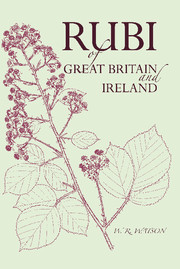Book contents
- Frontmatter
- Foreword
- Preface
- Contents
- INTRODUCTION
- I Environmental variations
- II Genetic intraspecific variations
- III Chromosomes and genes
- IV Reproduction
- V The species in Rubus
- VI Ecesis and migration
- VII Enemies, pests and diseases
- VIII Classification
- IX Collection and identification
- X Characteristics of the British-Irish bramble flora
- XI Cultivating native blackberries for fruit
- XII Note on the nomenclatural type species for the genus Rubus and subgenus Rubus
- XIII Key to the vice-county numbers
- XIV Signs and abbreviations
- ARRANGEMENT OF THE GENUS RUBUS LINN. IN AN ANALYTICAL KEY
- DESCRIPTIONS
- DRAWINGS
- Glossary
- Principal works consulted
- Index
II - Genetic intraspecific variations
Published online by Cambridge University Press: 05 June 2016
- Frontmatter
- Foreword
- Preface
- Contents
- INTRODUCTION
- I Environmental variations
- II Genetic intraspecific variations
- III Chromosomes and genes
- IV Reproduction
- V The species in Rubus
- VI Ecesis and migration
- VII Enemies, pests and diseases
- VIII Classification
- IX Collection and identification
- X Characteristics of the British-Irish bramble flora
- XI Cultivating native blackberries for fruit
- XII Note on the nomenclatural type species for the genus Rubus and subgenus Rubus
- XIII Key to the vice-county numbers
- XIV Signs and abbreviations
- ARRANGEMENT OF THE GENUS RUBUS LINN. IN AN ANALYTICAL KEY
- DESCRIPTIONS
- DRAWINGS
- Glossary
- Principal works consulted
- Index
Summary
Certain variable characters are found that are not known to be affected by any environmental condition and are presumably under genetic control. They are of a rather minor nature, and their presence or absence does not obscure the identity of the species. They are not due to hybridization; that is, they are not directly due to any fresh hybridization. Their appearance or disappearance in a new generation is apparently due to a recombination of genes that regularly takes place prior to the formation of gametes.
In some species one or other of these characters seems to have become fixed, and may be reckoned as one of the distinguishing characters of the species. In other species the same character may occur sometimes, not always. In yet other species it may not have been met with at all. For instance, pilose anthers occur always in Balfourianus, danicus, Drejeri, gratus, mucronifer and sciocharis; often in affinis, plicatus, regillus, silvaticus, vestitus and Winteri; never in adscitus, cardiophyllus, foliosus, pallidus, rudis and Sprengelii.
A survey is needed to learn in which species the following characters appear, and whether always.
1a. Leaves 3-nate to 4-nate-pedate or 5-nate-pedate.
1b. Leaves 3-nate to 5-nate-digitate or 5-nate-subdigitate, never 6-nate or 7-nate.
1c. Leaves 3-nate to 5-nate-digitate and sometimes 6-nate or 7-nate.
2. Number of sepals and petals where the number anywhere exceeds 5.
3. Petals glabrous on the margin, or pilose.
4. Anthers pilose; always?
5. Carpels glabrous; pubescent; pilose; bearded.
6a. Receptacle glabrous; or pilose.
6b. Receptacle hirsute at the base with a brush of hairs protruding below the lowest carpels all round.
To observe the bush, the best way is to take a freshly opened flower and thumb down the nearer stamens outwards. This will give a clear view of the young carpels also. Receptacular hairs often grow out between the carpels and must not be mistaken for hairs on the carpels. To remove any doubt it is wise to take off a few of the upper carpels for examination; this will also expose the receptacular hairs clearly.
A good deal of information has been collected under the above heads, and some of it is included in the descriptions. Until it is much more complete it will be unsafe to begin to draw conclusions.
- Type
- Chapter
- Information
- Publisher: Cambridge University PressPrint publication year: 2013



